Quartz
What do these photos tell you about what tools miners used?
Mine Near Hahn's Peak
The man in this photo is Pete Pourtalis. He is pushing a wheel- barrow loaded with ore from a mine. The photo was taken in 1906 at a mine near Hahn's Peak north of Steamboat Springs.
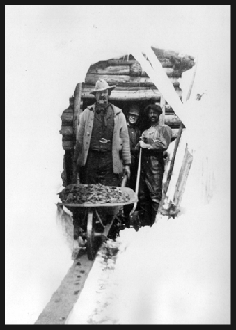
Photo: Denver Public Library, Western History Collection
More About This Topic
Placer mining in a newly discovered gold region usually lasted only a few weeks. The gold in the stream beds and creek banks was quickly taken out. The miners then searched for the veins of gold higher in the mountains from which the flakes of gold had come. The veins were embedded in quartz rock. Mining the quartz rock was much more difficult than placer mining. The men had to blast the rock out of the mountain and crush it before they could remove the gold.
Their Own Words
"The present condition of the Gregory Diggings is somewhat different from what it was some four or five weeks ago. Then hundreds of claims located on leads of decomposed quartz of a gold bearing character yielded regularly, handsomely and in some few instances, marvelously. But since then the decomposed quartz had given out in many of them and nothing remains but the solid rock, which cannot be possibly worked without the use of blasting and crushing apparatus."
Source: Letter from Denver City, August 12, 1959; Missouri Republican, August 26, 1859.
Mine Near Idaho Springs
The horse in this photo is pulling carts filled with silver ore out of a mine near Idaho Springs.
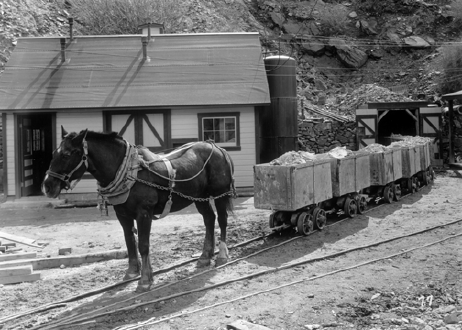
Photo: Denver Public Library, Western History Collection
More About This Topic
The silver ore in this photo came from deep inside the mountain. The mine owners used horse-drawn or mule-drawn carts that ran on rails to remove the heavy ore. Removing gold or silver from the quartz rock inside a mountain took more men and equipment than placer mining in streams
Their Own Words
“A short distance below the Gregory [mine in Black Hawk] on the left as you approach Central [City] is the Bobtail [mine] tunnel. . . . One of our favorite Saturday amusements was to tramp in and out of the tunnel as far as the shaft, dodging the numerous mule-drawn ore trains. The ore cars were . . . built of sheet steel, built in two sections which were hinged at the top. . . .”
Source: C. H. Hanington, “Early Days of Central City,” Colorado Magazine, 19 (January 1942): 5.
Inside A Colorado Mine
The miners in this photo are standing beside an ore cart inside a mine. They are working by candle light.
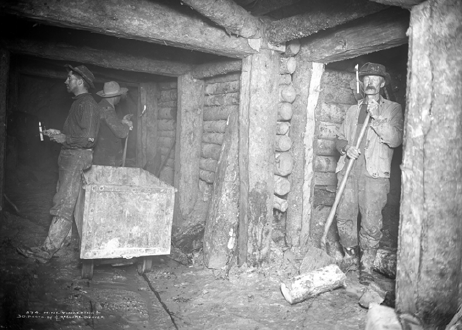
Photo: Colorado Historical Society
More About This Topic
Miners dug tunnels called adits deep into the mountains to find gold-bearing rock. They used logs and heavy timbers to keep the walls and roof of the tunnels from falling in on them. Hard rock mining was very dangerous.
Their Own Words
"So there is the economic picture as far as a single man earning the basic wage was concerned. Wages per month, $90.00; Food, $20.00, Lodging $10.00; balance of wages after payment of food and lodging, $60.00; twice as much as he would have received in his pay envelope for a month, for rough work in the East, on the basis of a seven day week."
Source: Leo J. Keena, "Cripple Creek in 1900," The Colorado Magazine, 30 (1953): 271.
Mine Shaft Near Cripple Creek
This photo shows a miner standing beside a vertical mine shaft. He is resting his hand on a windlass or lifting device. The photo was taken near Cripple Creek, where gold was discovered in 1891.
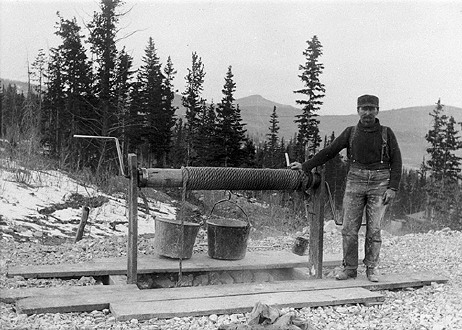
Photo: Colorado Historical Society
More About This Topic
Gold and silver ore also was removed by digging mine shafts into the ground. These mines needed machines to lift the ore to the surface. The machine in this photo was a simple windlass turned with a crank by hand. The windlass lifted buckets filled with ore.
Their Own Words
“These quartz veins run in various directions through the mountains. . . . After a crevice is discovered, the miner proceeds to open the claim by sinking a shaft or hole into it, which is effected [done] by blasting and the pick and shovel; and, as soon as needed, a windlass is erected over the shaft, in order to draw up the pay dirt and quartz. Or the miner may commence his work by tunneling into the base of the mountain, thus reaching the vein, and working it from beneath.”
Source: C. M. Clark, A Trip to Pike’s Peak and Notes by the Way, (San Jose: The Talisman Press, 1958 [originally 1861]): 97.
Saratoga Mine Near Central City
This photo was taken in the shaft house at the Saratoga Mine near Central City. The shaft house was built over the opening of the shaft that extended down into the mine. The men in the photo are standing in the cage that carried miners and ore carts up and down the shaft. This photo was taken about 1890.
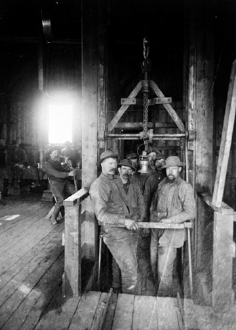
Photo: Denver Public Library, Western History Collection
More About This Topic
Large mines used iron cages to lift ore carts out of the mine. The cages were like elevators driven by a steam engine. The man on the left in this photo was the lift operator or "topman."
Their Own Words
"In 1900 only the big mines in the [Cripple Creek] District had cages. In the smaller mines men going on and coming off shift rode the bale of the bucket, that is stood on the rim of a one-ton bucket and steadied themselves by holding to the hoisting cable. Three hundred feet or so of that, when the hoist was working jerkily with an occasional back slip, engraves itself on one's memory."
Source: Leo J. Keena, "Cripple Creek in 1900," The Colorado Magazine, 30 (1953): 271.

